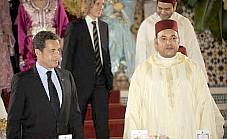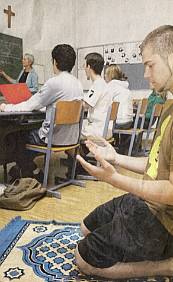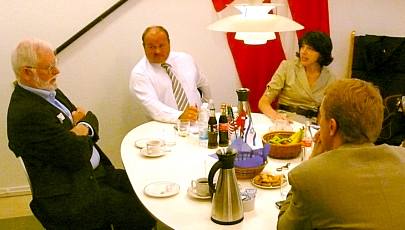Below is a preview of a post by AMDG, which will be featured at La Yihad en Eurabia early this week. There will be additional illustrations used in his own version of the post, so check in with his blog later. Gibraltar: Tunnel under troubled waters
Gibraltar: Tunnel under troubled waters
by AMDGOne of the resolutions I made after the
Counter Jihad workshop in Vienna was to write more frequently about Spanish issues in English. I had already done it a few times for Gates of Vienna; I will continue to do so as long as the Baron deems my contribution valuable. I am also open to the requests from readers.
I was asked in the last Counter Jihad workshop in Vienna about the project to connect Morocco and Spain by a tunnel. I had read and blogged about this issue
some time ago but I had not followed the latest developments. I have now investigated them, and I have found that the project goes on — still as a project in the study phase — but unchallenged. I present to you the results of my investigation.
* * * * * * * * * * * * * * *I will start with a curiosity. The idea of connecting both continents with a tunnel is not new. I have found an early speculation, a
proposal to the Spanish Ministerio de Fomento (Ministry of Civil Works) (PDF, Spanish), dated 1918, when the north of Morocco was a
Spanish Protectorate. The
first studies (PDF, Spanish) of the project were done during the
Primo de Rivera Dictatorship. In those days, the tunnel was considered a geo-strategic opportunity for Spain. It goes without saying that in the current demographic situation, it would aggravate the North African invasion of Spain, the second in history. Yes, it is not the economy, it is the demography!

The idea was forgotten up until 1980, when Spain and Morocco signed an agreement to study the feasibility of a “Permanent Connection Europe-Africa through the Gibraltar Strait”. In those days Spain had just approved the post-Franco Constitution and was ruled by a “moderate right” government. It may be worth mentioning that five years before, when Franco was dying, Morocco invaded the Sahara, a colonial province of Spain, which is still the responsible State for the territory according to “international law”. I find strange that a State makes such agreement with another one that has occupied part of its territory, but that is not the topic today.
There were a
number of studies (Spanish), which discarded the bridge and identified two possibilities for the tunnel. One shorter (14 km) but deeper (900 m); the other, longer (28 Km) but less deep (400 m). The possibility of building a bridge was discarded.
In the 80s and 90s, the studies stayed dormant, but in 2003 (at the end of Aznar’s government) the idea was woken up again.
Spain and Morocco agreed to start the technical studies to build a double railway tunnel with an intermediate service and maintenance tunnel. They agreed to spend €27 million euros in the years 2004 to 2006. For some reason it was not done. In March 2004, Spain suffered the most deadly terrorist attack of its history, carried out by Moroccan citizens — if we are to believe the official version. I assume that this could be the main reason.
In 2004, after those deadly terrorist attacks, the citizens chose to change to a socialist government. In November 2005, in the frame of the I Hispano-Moroccan Meeting, Morocco and Spain
committed to invest €10 million (Spanish) in the next year to further study the tunnel:
- - - - - - - - -
The investment to be made in 2005 and in 2006 will reach ten million euros, equivalent to quantity invested since 1996, when it was decided that a tunnel was preferable to the bridge originally planned.
According to the [Spanish] minister, the railway tunnel will be funded 50% each by the two countries. “We have conducted geological studies of the area; now begins the phase to analyze how to drill it”.
In summary, in 2005, the tunnel profits from a real boost: the investment on the project that connects Morocco to Europe was increased tenfold, even if it is inferior to the 27 millions previously committed. I have found no public information that could explain this lower budget.
The master plan for the project would be the following:
| 1. | | Drilling of the service tunnel. To be done as soon as the initial technical plan is drafted. The data gathered while drilling this tunnel will allow the fine-tuning of the railway tunnel project, reducing technical and budget risks. |
| 2. | | Drilling of one of the railway tunnels. |
| 3. | | While this tube is drilled, Morocco and Spain will work on the surface railway. |
| 4. | | Drilling of the second railway tunnel, if the traffic of the first tunnel confirms that a second one is needed. |
In 2006, the Spanish public company SECEG and the Moroccan SNED concluded a contract with a consortium of four companies: Typsa (Spanish), Ingemar (Moroccan), Geodata (Italian) and Lombardi (Swiss). Giovanni Lombardi, the designer of the Channel Tunnel, will carry out the technical detailed studies for the construction of the tunnel. This interview (Spanish) contains very relevant information. I have translated some of Lombardi’s statements:
“It’s an unprecedented challenge as regards the construction of major infrastructure, within the limits of technical feasibility”.
“By comparison, the English Channel was a child’s game… its depth and the water pressure are much smaller, the ocean currents are weaker, and the rock is more solid”.
It seems that the tunnel will be a technical challenge indeed, Moreover, for some reason Lombardi has failed to mention a most troubling issue: The tunnel will cross an active fault of the African and Eurasian tectonic plates, with a moderate seismic risk. I wonder whether any readers could tell me more about this issue.
The technical studies by Lombardi were supposed to be finished in one year, but I have found no update. In any case, the project goes on with the full political support of the Spanish government. In August 2007, in the frame of the Africa-Europe Summit held in Lisbon, the Spanish Foreign Minister confirmed the “determination” of both countries to have the tunnel in operation by 2025 at the latest. He declared that “Morocco and Spain are the two connecting countries, the two links of the chain needed to bring together both continents”.
I have also found this article in the WaPo (A ‘Chunnel’ for Spain and Morocco), which includes some statements by Karim Ghellab, Morocco’s minister of transportation: “It’s not easy to predict a date yet, but it is a project that will happen.”. Also worth noting: “It will completely change our world”. I am not sure it will change Morocco, but of course it would indeed change Spain, not necessarily for the better.
Now, putting apart the technical issues, the (multi)million dollar question is: Are there economic reasons to take those huge technical risks? Is there enough traffic between Morocco and Spain to justify the risk and the expense?
No, on the contrary, in Lombardi’s interview there is a reference to this aspect:
What percentage of passengers and cargo traffic will continue to use the ferry when the tunnel starts operating? Will the tunnel attract passengers who used to travel to Morocco or Algeria from Almeria, Alicante or even Sète (France)?
Last year [2006] Eurotunnel had 16 million passengers. The forecasts, not yet very accurate, suggest that the tunnel of the Strait will reach only half of that traffic in 2015, if it opens then. Ten years later it would reach around 10 million.
Passenger traffic in the Strait is also highly concentrated in the summer months, when nearly three million immigrant Moroccans return by car to their country on vacation.
The answer to questions about increased traffic depends largely on political considerations. If Algeria reopens its border with Morocco, closed since 1994, and if the two heavyweights of the Maghreb improve their cross-border road, the tunnel will be more viable from an economic standpoint.
So, it would have only half the traffic of the Channel Tunnel, which has been in deep financial troubles; moreover, the traffic will be concentrated in the summer season. Not very encouraging.
The article in the WaPo also contains some interesting financial figures:
Also looming large is the red ink incurred by the Chunnel. Private investors, who paid the bulk of the $20 billion price tag, have suffered heavy losses; the operator, Eurotunnel, has verged on bankruptcy for years.
While neither Moroccan nor Spanish officials have given a bottom-line estimate for their project, private analysts said it could cost $6.5 billion to $13 billion. The two nations said that they are a long way from resolving financing details but that they hope to rely heavily on the European Union and the private sector.
Now, this tunnel, which is much more challenging technically, cannot be cheaper than the Channel one; the $13 billion must include only some initial phase. If the Channel Tunnel, less challenging and with more traffic, has experienced large financial troubles and has been on the edge of bankruptcy, it is not difficult to conclude that the Strait Tunnel cannot be financially viable.
 There is one way out: getting political support, and Morocco — the main beneficiary — is playing its cards masterly: Morocco has involved France in the business. In the autumn of 2007, it started to plan for a high speed rail network. This plan makes no sense if the railway network was not connected to Spain; i.e. if there is no tunnel. Alstom and other French companies will build the high speed railway; a contract of €3 billion. The allocation to the French companies has been decided at the highest level (by King Mohamed VI); no international bidding process will be followed.
There is one way out: getting political support, and Morocco — the main beneficiary — is playing its cards masterly: Morocco has involved France in the business. In the autumn of 2007, it started to plan for a high speed rail network. This plan makes no sense if the railway network was not connected to Spain; i.e. if there is no tunnel. Alstom and other French companies will build the high speed railway; a contract of €3 billion. The allocation to the French companies has been decided at the highest level (by King Mohamed VI); no international bidding process will be followed.
Spanish companies have not even been invited, even though they also have the expertise and are currently building the Spanish high speed railway network. No need. Zapatero had already announced in his visit to Rabat in March 2007 that he is firmly decided to give a boost to the tunnel — so what does it matter?
Sarkozy will host a high level meeting on the Euro-Mediterranean Union next July, just before the national holiday that celebrates the take over of the Bastille, a privileged prison for aristocrats that had only two prisoners. I can envisage that this will be one of the most visible projects connected to that Union.
Is there any way to stop the tunnel? I do not know, but if there is one, it will be the financial aspect: without the financial support from the EU, the tunnel will not be built. This is the weakest point of the chain, the one most easily broken. In any case, in 2025, when the tunnel could be in operation, the fate of Europe will have already been decided.
The Polish parliament voted in April to ratify the Lisbon Treaty, a key reform treaty meant to streamline EU decision-making, but it needs the signature of the president to become definitive.


 “Cultures must be mixed,” says Mohammed Fahad, owner of a pub catering to young people in Innsbruck (the provincial capital of Tyrol). It was his goal to bring different cultures together, and he adds this “togetherness” of “indigenous” and “foreigners” has been friction-free.
“Cultures must be mixed,” says Mohammed Fahad, owner of a pub catering to young people in Innsbruck (the provincial capital of Tyrol). It was his goal to bring different cultures together, and he adds this “togetherness” of “indigenous” and “foreigners” has been friction-free.
 There is one way out: getting political support, and Morocco — the main beneficiary — is playing its cards masterly:
There is one way out: getting political support, and Morocco — the main beneficiary — is playing its cards masterly:  The Anglican Communion will be split tomorrow [Monday] when conservatives representing more than half its total membership will announce the formation of a new orthodox body to be a stronghold against liberal views. It will be schism in all but name.
The Anglican Communion will be split tomorrow [Monday] when conservatives representing more than half its total membership will announce the formation of a new orthodox body to be a stronghold against liberal views. It will be schism in all but name.
 All these decades later [since WW2], such basic experiential differences still play out in ways both obvious and subtle in the American and European disconnect on sundry issues and attitudes — the fissures Americans airily dismiss as anti-Americanism, or perhaps see as doctrinal differences (eroding but historical) over socialism and capitalism. Such differences have helped turn Europe into the European Union, a nation-destroying behemoth both driven and empowered by the infantilizing machinery of the welfare state. Indeed, so shockingly totalitarian is the orientation of the EU, it strikes me that President Bush’s misguided effort to democratize the Islamic Middle East might well have been better aimed at liberating the hostage peoples of the Brussels-dominated supra-state.
All these decades later [since WW2], such basic experiential differences still play out in ways both obvious and subtle in the American and European disconnect on sundry issues and attitudes — the fissures Americans airily dismiss as anti-Americanism, or perhaps see as doctrinal differences (eroding but historical) over socialism and capitalism. Such differences have helped turn Europe into the European Union, a nation-destroying behemoth both driven and empowered by the infantilizing machinery of the welfare state. Indeed, so shockingly totalitarian is the orientation of the EU, it strikes me that President Bush’s misguided effort to democratize the Islamic Middle East might well have been better aimed at liberating the hostage peoples of the Brussels-dominated supra-state. I brought Dymphna home from the hospital last night. She’s in excellent spirits, and will be back here posting before long.
I brought Dymphna home from the hospital last night. She’s in excellent spirits, and will be back here posting before long.